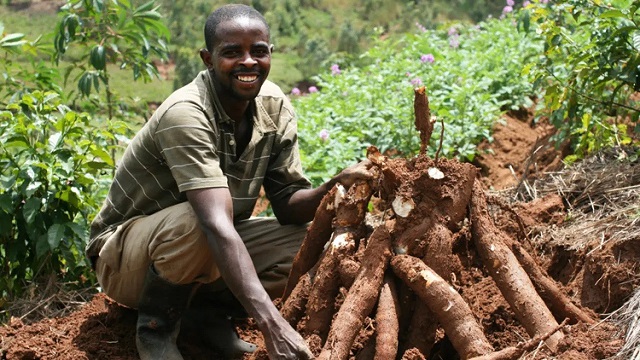
Hoima, Uganda | THE INDEPENDENT | Cassava has been a crucial food crop for many households in Bunyoro, but it did not have the same attention as cash crops like tobacco.
The situation is gradually changing with the introduction of new varieties as part of the livelihood restoration under the oil and gas sector.
Smallholder farmers in Buliisa, Hoima, and Kikube are being helped to access quick-maturing and disease-free varieties. Agronomists have also been deployed to help farmers to transform cassava from food to a cash crop.
In Buliisa District, TotalEnergies contracted Living Earth Uganda to extend livelihood restoration for the project-affected persons under the Tilenga Project which has had over 5,000 persons relocated from the area where some well pads and the Central Processing Facility and flow lines are to be located.
The project supports farmers to access and utilize good agronomic practices so as to improve their household income levels.
Under the training component of the project, farmers are given a chance to choose which enterprise to undertake. The enterprises include cassava farming, citrus fruits, and animal husbandry.
Ocowun Christopher, a Public Relations Officer with TotalEnergies Uganda says that most people opted for farming.
“Many of them have big acreage of cassava gardens. There are those that opted for animals. So they are given support in the areas that they opted for” said Ocowun. “Our goal at the end of the day is to make the lives of the people better and to ensure the sustainability of the project”
Robert Akugizibwe, an Assistant Agronomist with Living Earth in Buliisa told URN that more farmers not just in Buliisa have opted for cassava because it is easier to grow and that it withstands climatic conditions in the Albertine.
NAROCAS 1 cassava variety has been introduced in the three districts of Hoima, Buliisa, and Kikuube. “NAROCAS 1 matures very fast so within eight to ten months, they are ready to harvest. We advise them to do staggered planting. Within eight months, they harvest, do the chipping, do the storage, and wait for another season to plant” said Akugizibwe.
He said farmers are equipped with good agronomic practices so that they do proper weeding, pests, and disease control and then add value so that they don’t lose anything at every stage.
“Like in weeding, you can lose up to 60% if you don’t control weeds. But with the cassava, we have introduced, once it develops a canopy develops, then the weeds are controlled”
Sixty-three-year-old Dick Dezere has been a farmer in Ngwendo Sub County Buliisa District. He is one of the farmers who have adopted the new cassava variety.
Speaking through a translator, Dezere told URN that he and other farmers have been planting old cassava varieties which he said were prone to diseases like cassava brown streak disease(CBSD) and Cassava Mosaic Disease (CMD).
He said that in the past, cassava stems would be vertically planted but with training, most farmers now dig holes instead of vertical planting. Dezere told URN that once he harvests from a five-acre garden, he plans to sell it so that he can buy more land.
Dezere like many farmers in Bunyoro had been producing the crop at a small scale and selling it to the middlemen but with the knowledge acquired, he could graduate from subsistence farming. The 2019 annual Agricultural Survey found that about 6.9 million Ugandans were engaged in smallholder agriculture.
The NDP III indicates that a high proportion of the population is still dependent on subsistence agriculture due to low agricultural production and productivity, poor storage infrastructure, poor market access, and low-value addition.
Some of those challenges are being addressed in the Tilenga Project area where extension workers from Living Earth Uganda are deployed.
In most parts of Bunyoro, cassava is a food security crop, with some cash sales. In Kigwera and Ngwedo processing cassava began with fermenting it, and then sun-dried for making cassava flour.
But a new-time saving method involving a diesel crushing machine has been introduced to farmers as part of the value-addition component in the cassava value chain.
Mubot Paris is a resident of Avogera village located in Ngwedo Sub County. He is a member of Nogm Okelo group comprised of thirty cassava farmers. He told URN that the chipping machine has made work a lot easier for women because it takes less time to cut the harvested cassava.
Philemon Nganda, an Agronomist in Charge of Value addition at Living Earth Uganda says that the machine can crush one tonne of cassava tubers within one hour.
“Once it is chipped, it is put in the sun for drying, and it takes two to three hours for them to dry. Previously in a traditional way, the drying would take a whole week because they would cut them into bigger pieces,” said Nganda.
The chipped cassava is then spread on a raised platform off the ground and dried under the sun.
Juliet Kawambe, a housewife in Avogera village emerges from her grass-thatched house with two bowls filled with cassava chips.
One of the bowls contains clean neatly chipped cassava, while the other is filled with bigger chips chipped using the traditional method.
She said the older methods of cassava post-handling were tedious because the chips took longer to dry especially when harvested during a rainy season.
“The new method of drying cassava chipped by a machine takes only a few hours or one day when the sunshine is not much,” said Kawambe.
In Avogera village, post-harvest handling of cassava had for long been deemed a responsibility of women and girls. Women would bear the responsibility of ferrying the cassava from the garden, peeling it, cutting it into chips, and drying it.
Lately, men in this village are involved in it after realizing that with better post-handling, the cassava crop can earn them more and improve food security at their homes.
On a sunny afternoon in Ngwedo Sub County four men are seated under a mango tree facing a big heap of freshly harvested cassava tubers. Each of them holds a knife as they peel the tubers for drying.
After peeling, cassava tubers are washed with clean water, and placed on a tarpaulin under the sun ready for chipping. Tubers are then crushed into small pieces using a diesel-powered mill. Studies within Uganda have found that cassava is prone to a condition known as postharvest physiological Deterioration (PPD.
Those losses are estimated to be as high as 40-60% within the first seven days after harvest and can reach 100% within the next 2-5 days if the roots are not consumed or processed into other more stable products. Cassava tubers also contain a substance called hydrogen cyanide, which is toxic to human beings.
According to Philemon Nganda, apart from the fact the better-handled cassava fetches a premium price at the market. Uganda currently has an annual net deficit of cassava and cassava-derived products of over 70,000 MT. The deficit is expected to grow to over 900,000 MT due to population growth.
****
URN
 The Independent Uganda: You get the Truth we Pay the Price
The Independent Uganda: You get the Truth we Pay the Price

